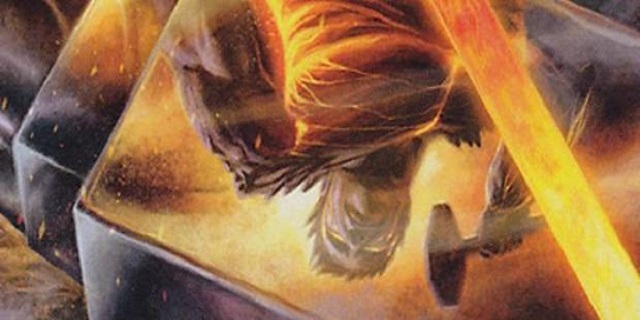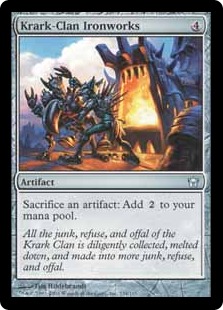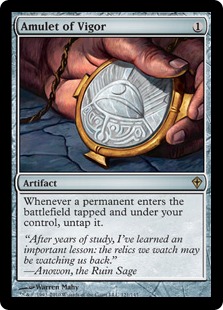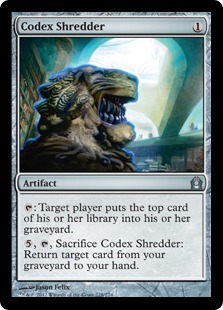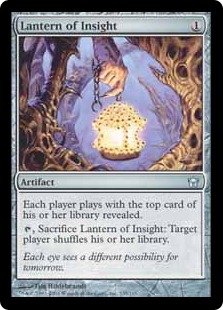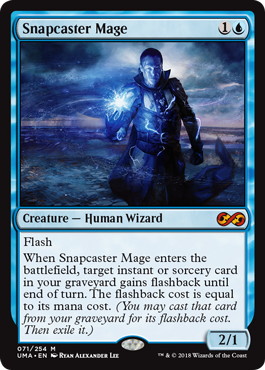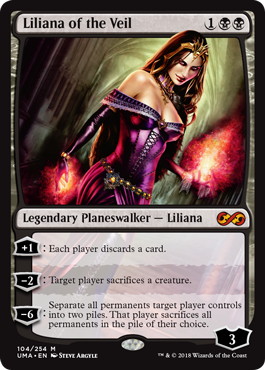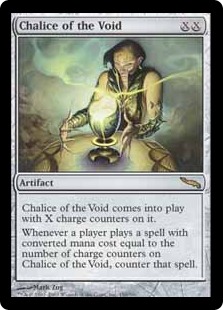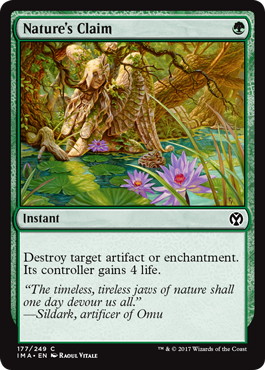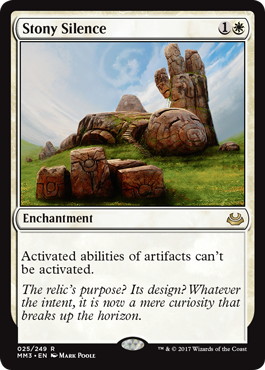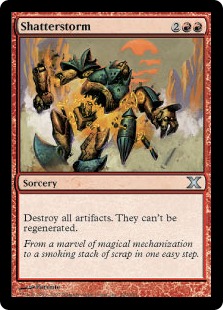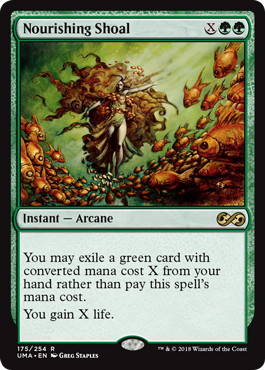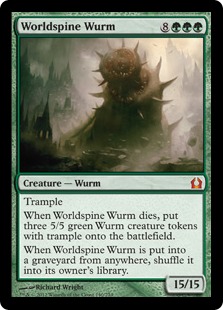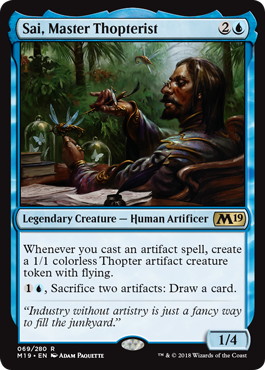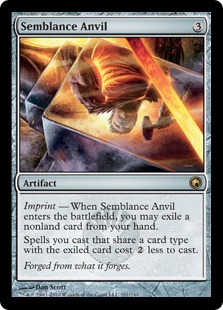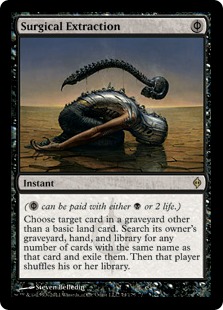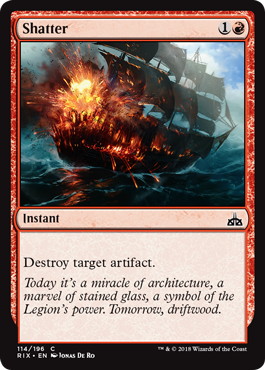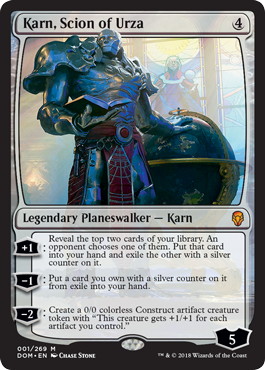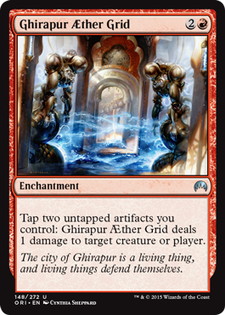Introduction
As you probably know, on January 21st Modern got hit by a ban list update that removed 《Krark-Clan Ironworks》 from the format. While the deck’s exit from the format saddened me greatly, it was probably well-deserved. After all, the reason I kept playing and working on it as much as I have, was because I was confident that I’m just doing something much more powerful than my opponents.
When it comes to deck selection, I am definitely not an unbiased player. I am strongly attracted towards decks that are powerful and proactive, with bonus points for abusing odd or unusual interactions in surprising ways – that’s just what I enjoy, while I typically stray away from pure control decks or creature aggro decks.
While as a professional player and a member of the Magic Pro League winning is high on my list of priorities, I do prefer to do it with combo decks if possible. That makes Modern a perfect place for me, because what the format is often maligned for, I just plainly enjoy.
Throughout my Magic career so far, I always considered Modern to be my strongest format. I made my first steps into competitive magic by playing unhealthy amounts of Amulet Bloom on Magic Online, treated Death’s Shadow Zoo as my main weapon in the format for as long as 《Gitaxian Probe》 was legal, had a part in developing the 《Whir》 Lantern deck that Luis Salvatto used to win Pro Tour Rivals of Ixalan a year ago, on top of all three of my GP top 8s being in Modern.
Generally speaking, it seems to me like I have a reasonable knack at identifying powerful and potentially bannable combo decks, and today I will try to share with you what are the qualities I learned to look for in decks I want to be focusing my efforts on.
1. Proactiveness & Potential for Fast Wins
This is a gospel repeated by most players and writers – you will find more success in Modern if you are proactive. Control and Midrange decks have waxed and waned in popularity and results throughout the lifespan of Modern, but they very rarely and typically briefly are considered to be the decks to beat.
Notably, I think this is an area where ultimately me beloved archetype of Lantern Control has fallen and why I no longer consider it to be a premier competitive option – it is inherently a reactive deck, and with new cards and archetypes entering Modern, at some point 《Codex Shredder》 and 《Lantern of Insight》 lock stopped being a great universal answer, and nowadays when I try to pick it up I just feel short on slots, unable to find space to fit all the necessary answers for different opponents I might run into.
Without an ability to produce turn three-four wins, you inherently put yourself in a position where you need to answer more of your opponent’s cards, which is obviously tough in a format with a wide card pool like Modern.
Being proactive and quick puts a floor on how bad your matchups can and puts you in a better position against random, surprising brews opponents can throw at you at any time in Modern. This always contributed to my lack of willingness to play 《Snapcaster Mage》/《Cryptic Command》 or 《Liliana of the Veil》 midrange decks in modern.
2. Complicated and Unintuitive Interactions
While it might sound weird or pretentious, it is actually a pretty good prognosis of whether a new deck might have the potential to be broken or not.
Very few people employ a purely Spike approach to the format and do extensive research when it comes to their deck choices. If a deck is weird, hard to play, or just looks plain wonky, it WILL discourage players from picking it up and odds are it might go unnoticed and misunderstood for quite some time.

Justin Cohen
Image Copyright : MAGIC: THE GATHERING
It’s easy to think that if an archetype was good enough, somebody would already figure it out, but it just keeps proving not to be the case. Amulet Bloom was ridiculously overpowered when it had access to it’s now-banned card, but it took until Justin Cohen’s PT Fate Reforged finals appearance for general player base to gain any respect towards how this deck blended turn two wins with resilient late-game 《Tolaria West》 chains.
The Lantern was playing the game in a way that many players would just rather not play. 《Krark-Clan Ironworks》 mana ability window loops caused many headaches, and it wasn’t exactly the easiest to play online. Factors like those drive players away, with fewer players there is less exposure, less manpower working on an archetype means that optimal decklists will coalesce much slower.
Of course, this entire paragraph is just a pointer towards a given deck’s potential, not a prerequisite – but just remember not to dismiss decks out of hand. I spent a lot of time not believing in the power of early builds of Whir Prison, not bothering to try them out, getting discouraged by some of the weirder deckbuilding choices, but after over a year of being developed by basically just one person in Magic Online player susurrus_mtg, it is now a real and well-respected Modern archetype.
Speaking of Whir Prison, another important point rises up – if a deck is powerful, yet not very popular due to some non-entirely-gameplay reasons, you can gain huge benefits in sideboarding. I am talking there both about the expected amount of reps from your opponents to be lower than if you picked the most popular archetype, but also about the strain it puts on contents of everyone else’s sideboards.
Prison is a very powerful deck, sporting an excellent matchup against 《Arclight Phoenix》 decks, utilizing lock piece artifacts and a ton of 《Welding Jar》, 《Spellskite》 and 《Chalice of the Void》 to protect those. The unique structure of this deck makes cards that are typically used to fight 《Mox Opal》 decks are not at their best here.
《Nature's Claim》 is frequently not even a justifiable card to bring a lot of the times, while 《Ancient Grudge》, 《Abrade》, and 《Stony Silence》 might also not yield the exact results you would want, running head first into a wall of Jars.
On the other hand, if a player wanted to improve their matchup versus Whir Prison, they can always turn to sideboarding cards like 《Shatterstorm》, which are virtually unbeatable for the Prison deck. That puts a natural cap on how popular Whir Prison could become before it becomes a victim of its own success.
This means that while it might be, and I think it is a great deck to play in modern right now, you might need to reserve the wilingness to jump ship if it ever gathers too much attention.
3. Inherent Resiliency
One deck I spent a lot of time working on when it first appeared, before realizing that it is fundamentally not great, was 《Griselbrand》 combo. It first popped up in 2015, and at first glance was extremely scary – multiple avenues in which it could combo off, ability to win on turn two, what’s not to like? Well, for some reason this deck is extremely fringe nowadays and avoided getting ever hit by a ban.
I was struggling for some time to internalize why exactly was the deck’s downfall, but at some point I understood: the level of resiliency presented by 《Griselbrand》 Combo was very low. The combo pieces required in your deck left you with arguably up to 18 dead cards in your deck, with cross-synergies between some, but not all of them (can’t exile extra 《Griselbrand》 to 《Nourishing Shoal》; can’t 《Goryo's Vengeance》 back a 《Worldspine Wurm》), on top of a fundamental contradiction between your 《Faithless Looting》 plan and trying to go for a resource sensitive 《Through the Breach》.
Compared to Amulet Bloom’s natural ramp plan and KCI juking opponents with sideboard 《Sai, Master Thopterist》, 《Griselbrand》 combo needs to make huge investments and hope they will pan out, instead of gradually building and improving its own position. Modern sideboard hate cards are too powerful to try to cross your fingers and dodge them continuously. Lack of any true sideboard options didn’t help 《Griselbrand》 either.
I already touched on how Whir Prison, a deck whose position I like, gaining strength from being naturally resistant to simple shatter effects. The way it all differs for the Prison deck is that it doesn’t necessarily check out the first box – it doesn’t win quickly.
《Shatterstorm》 is as devastating against Whir as 《Blood Moon》 was against Amulet Bloom, but Amulet was naturally much better set up to fight it’s hatecard, being able to just pull off insane early wins and go under it.
Considering all of that, I would be surprised if Whir Prison would necessitate a banning for power level purposes in the future, barring some absurd new printings.
As I was saying in my KCI deck Guide , a great sideboard plan can really make a deck skyrocket in power level. I only became truly invested in Ironworks once I realized how much the addition of 《Sai, Master Thopterist》 changes things, and I believe the deck wouldn’t end up getting banned had 《Sai》 never been printed. A great game one deck with an excellent sideboard is truly a godsend that only happens rarely, so cherish those when you can!
The Slot Machine Combo Deck
We just 5-0'd with this on my stream, should have banned Mox Opal and Stirrings dear wotc pic.twitter.com/bY2Zxpl60K
— Piotr Glogowski (@kanister_mtg) 2019年2月15日
Last week, I got convinced by a viewer to give a shot to a deck that effectively is the spiritual successor of KCI, resulting in this tweet kind of blowing up and turning 《Semblance Anvil》 from a bulk rare into a ten-dollar card overnight. While my tweet was obviously exaggerated to make it more flashy, let’s take a closer look at the build given what I just said in the first part of my article:
The simplest goal of this combo deck is to assemble 《Semblance Anvil》, 《Grinding Station》, and a pair of 《Myr Retriever》 to create a loop that allows you to mill your opponent’s deck.
You can also assemble a 《Pyrite Spellbomb》 loop if milling your opponent is not an option, but it’s slightly more complicated. There is a lot of flexibility between the pieces – getting 《Grinding Station》 out early, right after 《Semblance Anvil》, allows you to cycle continuously with your eggs while at first targetting yourself with the ability, allowing you to access your second Myr from the graveyard if you already have one.
Keep in mind that the sample size that I’m operating on is very small so far, but I can definitely see this deck being a fairly strong game one choice, ready to race many archetypes Modern could throw at you.
Is this deck resilient, however? This is where things got interesting. The combo core is weak to both graveyard hate, 《Surgical Extraction》, 《Shatter》 effects, 《Stony Silence》, counterspells, and on top of that, 《Semblance Anvil》 requires you to exile an extra spell from your hand, making it lackluster even against discard spells. Not the best prognostics for a combo deck.
Trying to sidestep that, when facing aggressive, midrange, or control decks during my initial league, I just leaned back into my KCI experience and transformed away from the combo, cutting all or nearly all 《Semblance Anvil》 and 《Grinding Station》 while presenting an artifact control deck with 《Sai, Master Thopterist》, 《Karn, Scion of Urza》, 《Ghirapur AEther Grid》 and interaction.
This strategy keeps proving to be effective at punishing decks that water themselves down too much by including too many hatecards. Where this deck struggled a bit, were matchups that had both a plan going easily over the top of your midrange threats and were able to board in a few pieces of interaction to shut you down.
Think Storm with a 《Abrade》 and 《Remand》, Tron with a few 《Nature's Claim》 and 《Surgical Extraction》, or Dredge keeping up an 《Ancient Grudge》 that they milled. Those are the factors and matchups I feel I would need to address before gaining confidence in this deck’s power level. Given how early this deck is in its development, I am certainly motivated to try out different approaches before giving up on this shell.
Take care, try to find another Amulet Bloom or Ironworks, and until the next time – next weekend I’m going to play the Mythic Championship in Cleveland, so wish me luck there!


